The Adventures of Backpack Pat – A History Lesson of the East Valley at the Superstition Mountain Museum
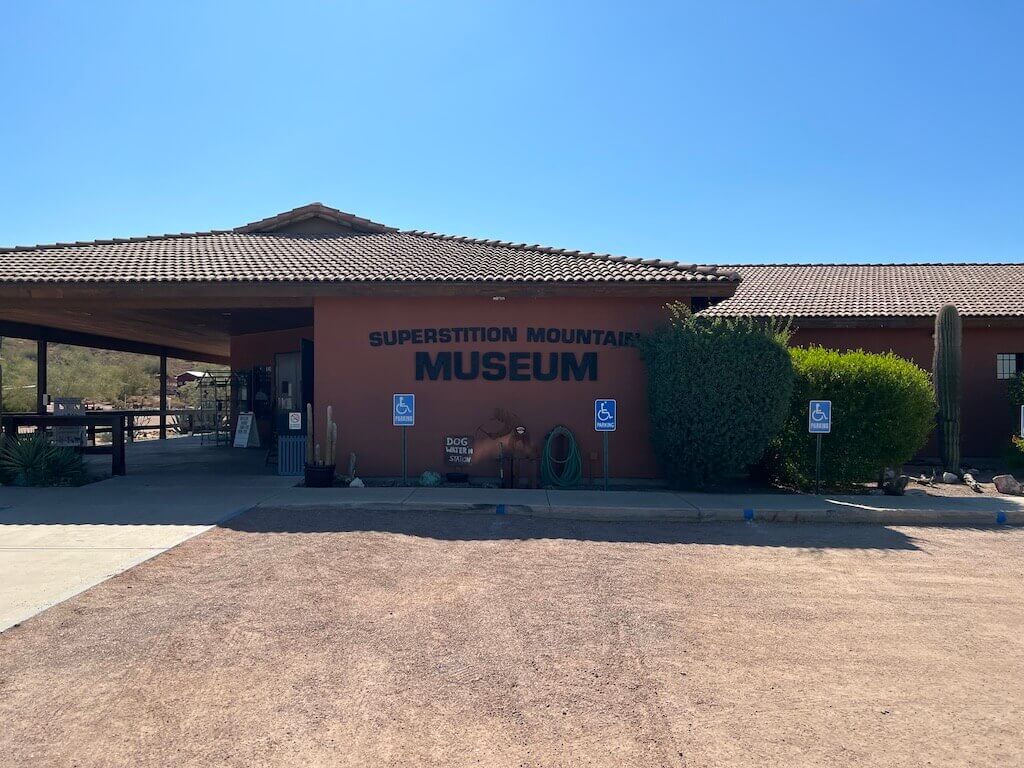 The Superstition Mountain Museum, located on the historic Apache Trail (State Route 88), helps tell a story that transcends modern-day Phoenix East Valley and brings museumgoers to a whole series of different people and cultures, from the Hohokam Native Americans to Elvis. A variety of stories are blended together on the museum’s 15-acre property, in a ‘something for everyone’ setup. My trip to this museum was filled with striking views of the Superstition Mountain, lots of, “I did not know that about this area”, and, of course, quite a few spectacular photos – and you get to see them. Do note, that these photos will not be as good as visiting this museum in person.
The Superstition Mountain Museum, located on the historic Apache Trail (State Route 88), helps tell a story that transcends modern-day Phoenix East Valley and brings museumgoers to a whole series of different people and cultures, from the Hohokam Native Americans to Elvis. A variety of stories are blended together on the museum’s 15-acre property, in a ‘something for everyone’ setup. My trip to this museum was filled with striking views of the Superstition Mountain, lots of, “I did not know that about this area”, and, of course, quite a few spectacular photos – and you get to see them. Do note, that these photos will not be as good as visiting this museum in person.
Where is Superstition Mountain Museum?
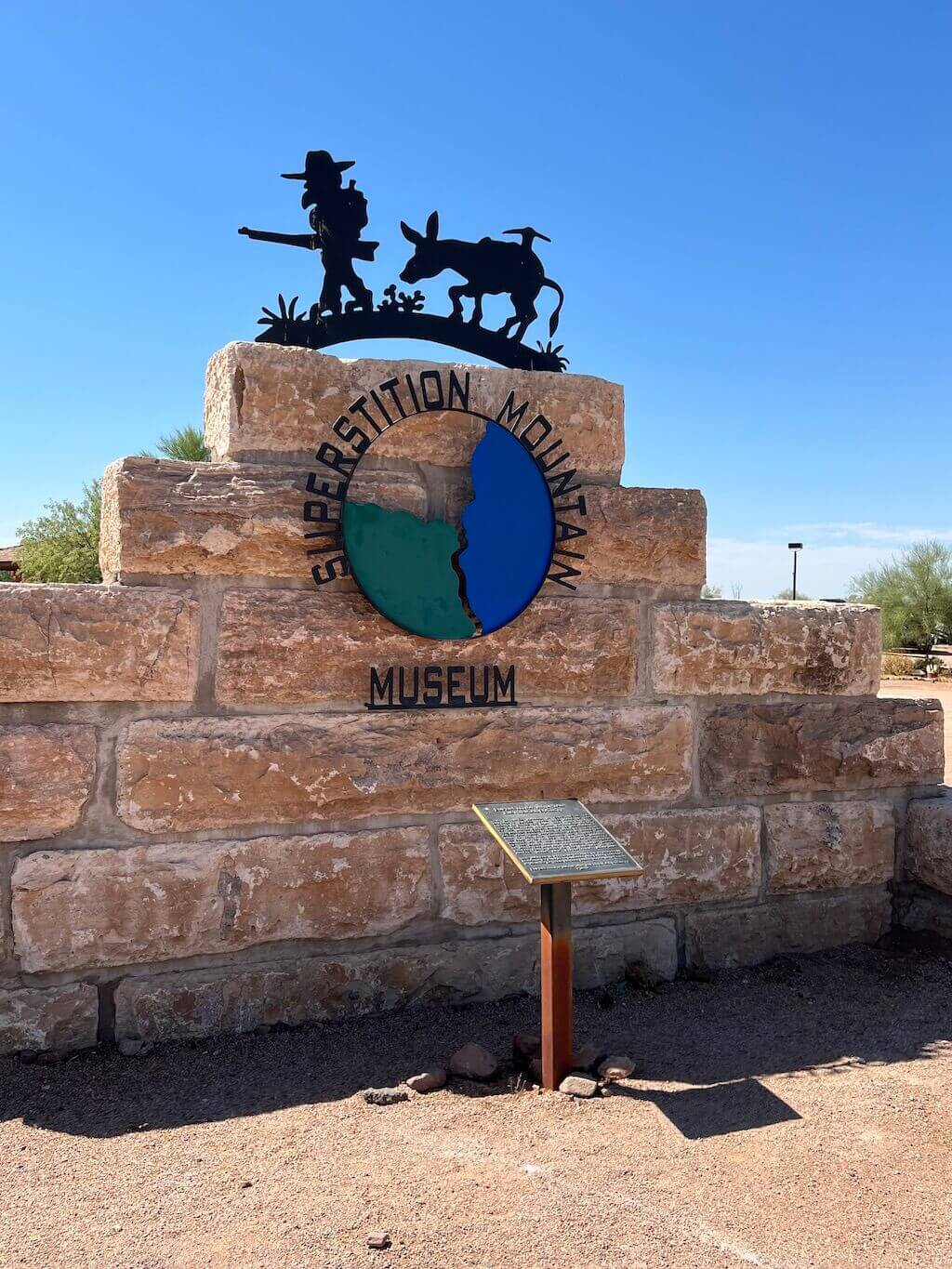 Tucked away a couple of hundred feet back from SR 88, the Superstition Mountain Museum building is preceded by a couple of signs, welcoming locals and visitors to explore the museum before trekking over to Goldfield Ghost Town or Tortilla Flat, all of which are on the historic Apache Trail. Once you are parked, there are many aspects of the property that will catch your eye, which will probably lead to the question, “What should I visit first at Superstition Mountain Museum?”.
Tucked away a couple of hundred feet back from SR 88, the Superstition Mountain Museum building is preceded by a couple of signs, welcoming locals and visitors to explore the museum before trekking over to Goldfield Ghost Town or Tortilla Flat, all of which are on the historic Apache Trail. Once you are parked, there are many aspects of the property that will catch your eye, which will probably lead to the question, “What should I visit first at Superstition Mountain Museum?”.
What’s There to Do at Superstition Mountain Museum?
First-time museumgoers will also quickly realize that the Superstition Mountain Museum is one of the best things to do when learning about the Superstition Mountains and the Apache Junction area. One will also quickly realize that this land has been host to many other cultures and populations prior to our time. We are simply here at a point in time, and we are currently adding to the collection of historical events and travelers that have called the Superstition Mountains home. I certainly had no idea how many aspects there were to this museum and property, so I feel that it is best to break down some of my highlighted experiences below based on the various portions of the museum and certain eras of history.
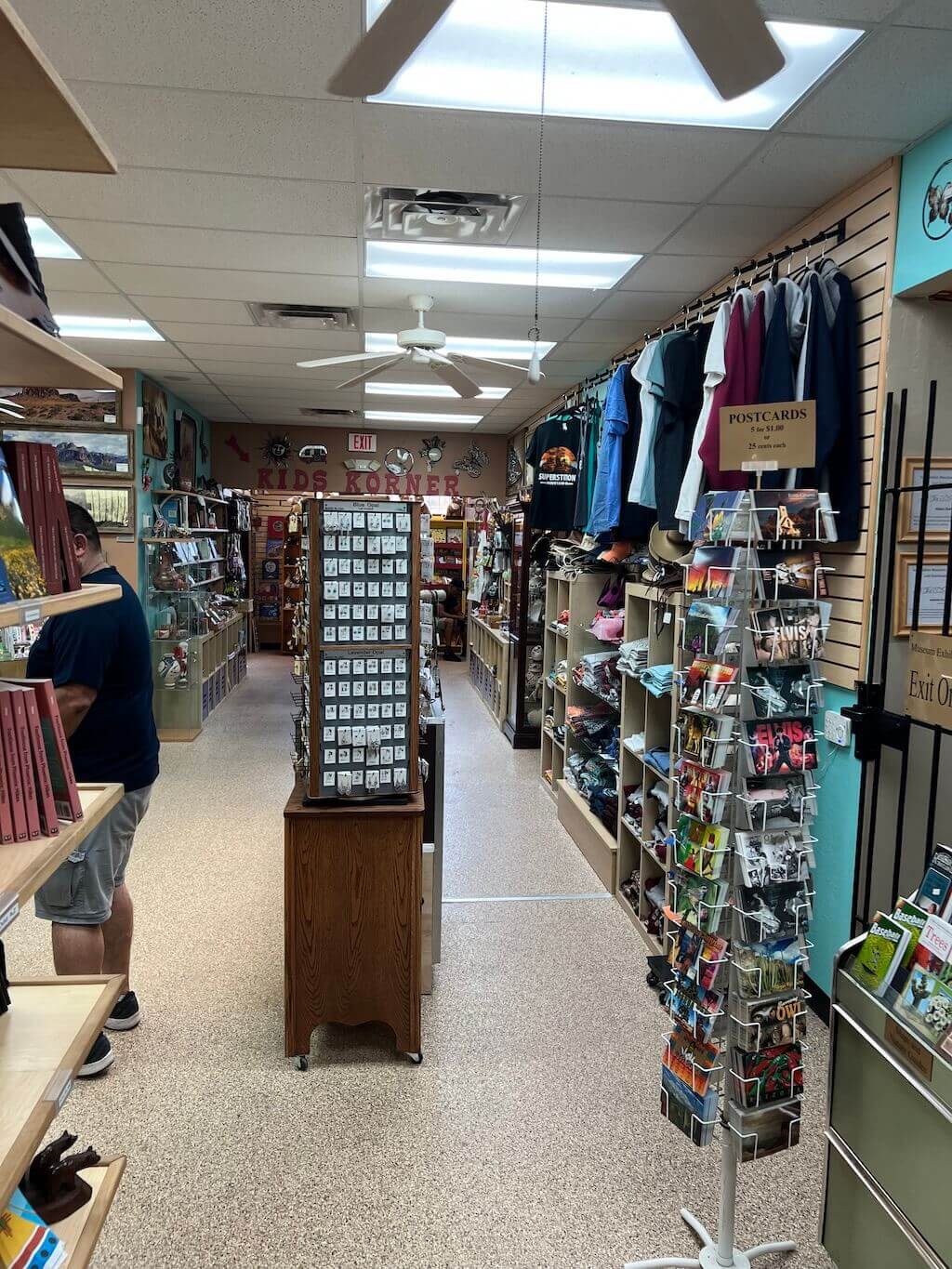
Superstition Mountain Museum Main Building, A Great Starting Point
To help get one’s day started at the museum, go through the main doors of the museum building and a friendly representative will greet you with a smile and a handout to help guide you during your visit. The first room one will encounter in this building is the gift shop and bookstore. There are several little nooks and crannies filled with gifts that can help you remember your visit. From a little Christmas section to the “Kids Korner” section that is filled with books, puzzles, and a few shelves of candy, to the primary gift shop area with mugs, hats, t-shirts, postcards, photographs, artwork, and jewelry, there is surely something for available for all of the visitors. The proceeds of the gift items help to sustain the operations of this museum, which, in turn, helps to keep the history of the old west and the Superstition Mountains alive.
Main Museum Exhibit Area
Past the gift shop area is the main museum exhibit area. There is a small fee to enter this area as the proceeds also go to help maintain the property and keep the temperature of the room controlled since there are several delicate artifacts. Once inside the exhibit area, you will notice a video playing that explains how the Superstition Mountains got its name. Once past the welcome video, be sure to meander through the whole exhibit area as there are many different parts of history that are covered. In fact, if you look up near the ceiling you will see a timeline documenting events and groups of people settling in the area starting as early as 300 AD by the Hohokam tribe.
Life as the First Settlers
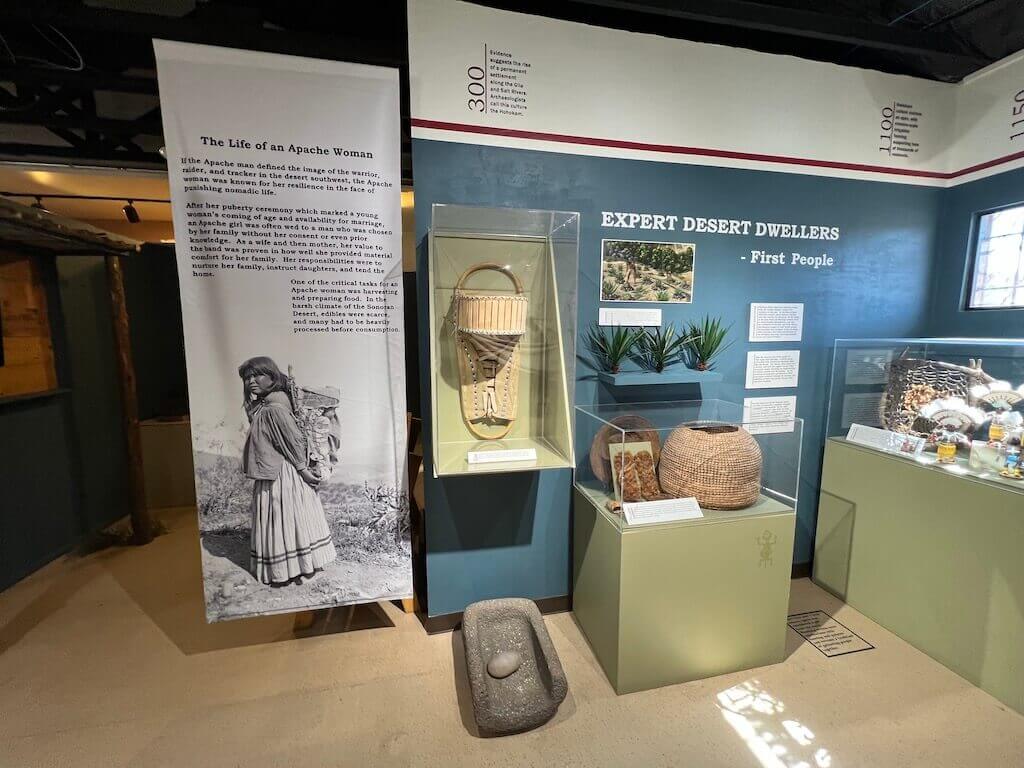 The museum staff does a wonderful job of highlighting how life came about for both Native Americans and early settlers. The exhibit area has dedicated space to showcase stories from all walks of life that once settled in this area including the efforts made to transition this land from Native Americans to early expansion efforts by other settlers. Part of the museum floor is dedicated to specific Native American tribes such as the Apache tribe. One exhibit discusses the life of an Apache woman and how she had to search the desert to gather food for her family.
The museum staff does a wonderful job of highlighting how life came about for both Native Americans and early settlers. The exhibit area has dedicated space to showcase stories from all walks of life that once settled in this area including the efforts made to transition this land from Native Americans to early expansion efforts by other settlers. Part of the museum floor is dedicated to specific Native American tribes such as the Apache tribe. One exhibit discusses the life of an Apache woman and how she had to search the desert to gather food for her family.
Another section of the museum floor depicted life for early American settlers. One exhibit pointed out the strategic location of forts that were constructed near major trading routes such as Fort McDowell which was located along the Verde River.
The Tale of the Lost Dutchman’s Gold and More
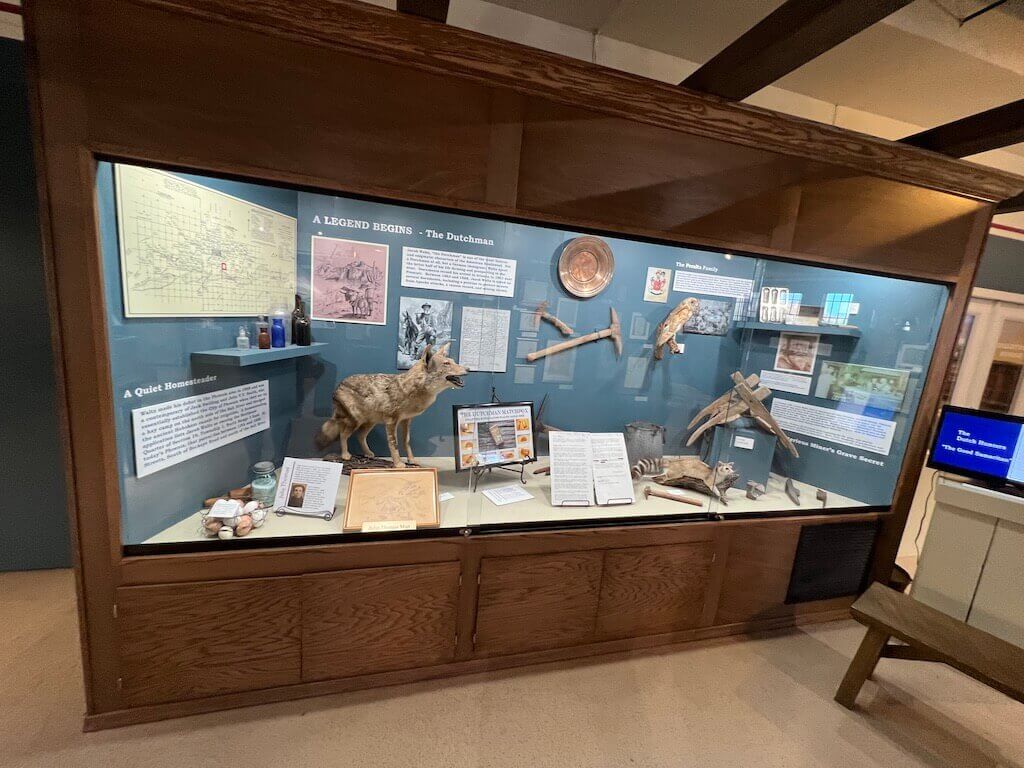
The exhibit area also touches on one of the main reasons that so many settlers moved out west, gold. One settler, in particular, has a storied history in this part of the country, Jacob Waltz, who is known as The Lost Dutchman, and his hidden gold. The tale of Jacob Waltz and the gold hidden within in the Superstition Mountain range is on full display as hundreds of people have attempted to look for the hidden gold after his death in 1891. Some of the maps created by previous gold hunters are hanging on one of the walls as the story of the Lost Dutchman’s Gold still captures the attention of people today.
One of the 5 C’s of Arizona, Cattle
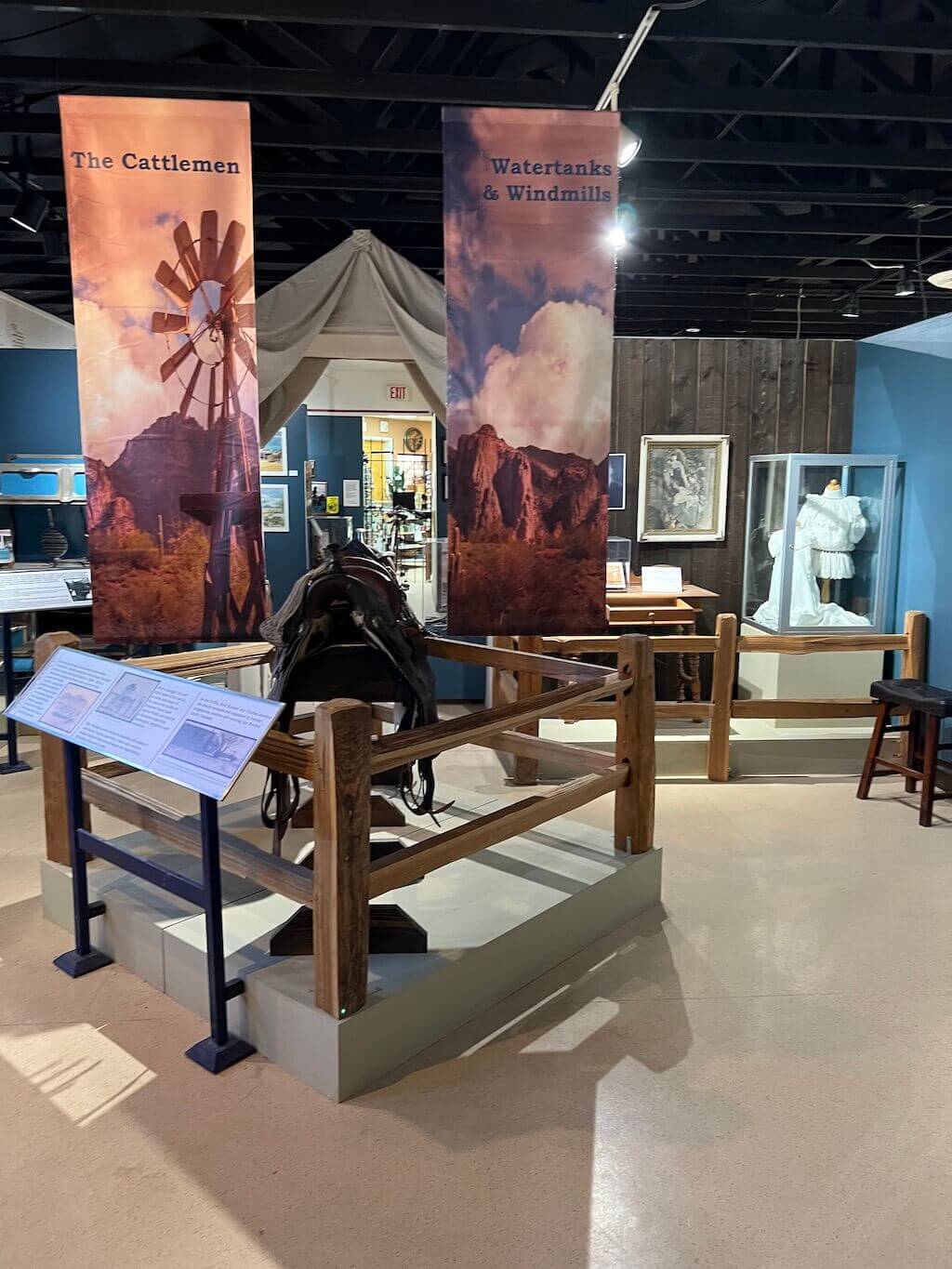 Given the wide-open areas, the land surrounding Superstition Mountain eventually opened up to cattle ranchers. This part of Arizona’s history is well displayed within the Superstition Mountain Museum as shown in the Weekes Ranch exhibit. The Weekes Family settled in the area in the late 1880s and formed Weekes Ranch. Growth did not come without its challenges as a prolonged drought reduced their cattle count for a period of time.
Given the wide-open areas, the land surrounding Superstition Mountain eventually opened up to cattle ranchers. This part of Arizona’s history is well displayed within the Superstition Mountain Museum as shown in the Weekes Ranch exhibit. The Weekes Family settled in the area in the late 1880s and formed Weekes Ranch. Growth did not come without its challenges as a prolonged drought reduced their cattle count for a period of time.
As a response, the Weekes family expanded their offerings and opened a logging business, saloon, and general store to folks passing through the Apache Trail which was known as Weekes Station. In fact, Weekes Station existed on the land where the Superstition Mountain Museum now sits. Ranchers are a huge part of the Superstition Mountains storied past and various ranches still dot Arizona’s landscape today. While there is so much history to explore inside the main building, it was time to traverse outside and see the sights and sounds of the rest of the museum property starting with Apacheland Movie Ranch.
Apacheland Movie Ranch & Barn
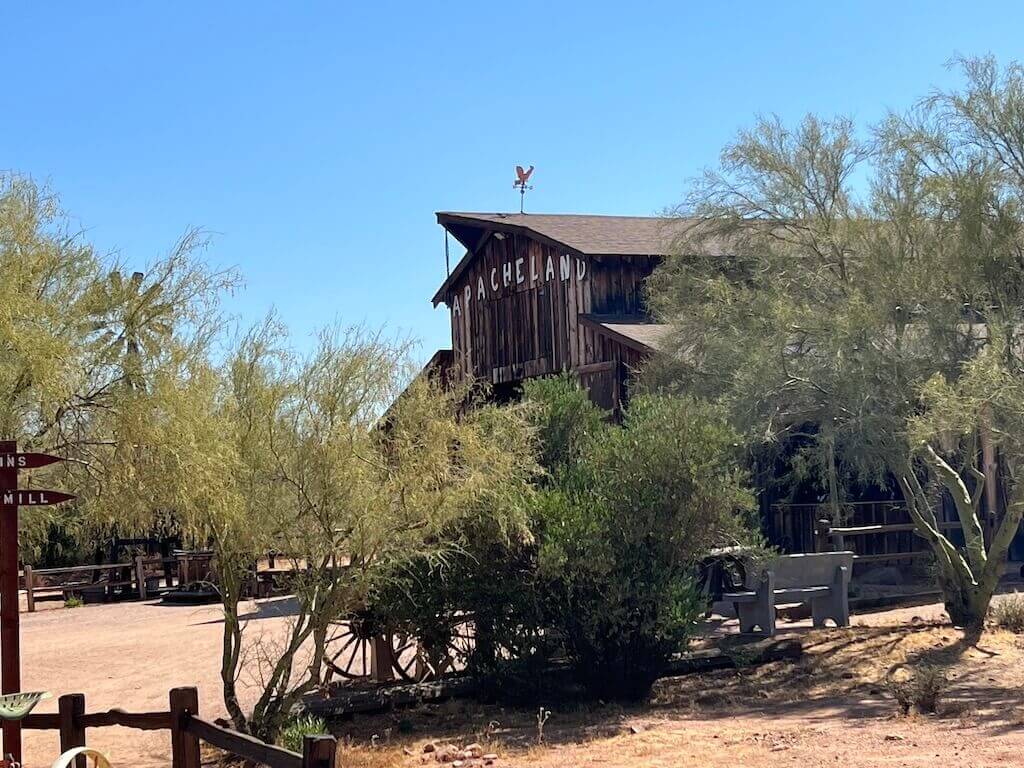 It is amazing to think that the Superstition Mountain range and the Apache Junction area would nearly become the “Hollywood of Arizona” with the rise in Western movies. Movie stars such as John Wayne, Steve McQueen, Linda Evans, Kenny Rogers, and the King of Rock and Roll himself, Elvis Presley, graced their presence in the East Valley when shooting iconic movies including Broken Land, Arizona Raiders, Charro!, and more. The original Apacheland Movie Ranch was technically in the area that is now Gold Canyon, but two separate fires devastated the original set and it was not reconstructed. The remaining buildings, including the Apacheland Barn, were taken apart, board by board, and reassembled on the Superstition Mountain Museum property for the public to experience and enjoy.
It is amazing to think that the Superstition Mountain range and the Apache Junction area would nearly become the “Hollywood of Arizona” with the rise in Western movies. Movie stars such as John Wayne, Steve McQueen, Linda Evans, Kenny Rogers, and the King of Rock and Roll himself, Elvis Presley, graced their presence in the East Valley when shooting iconic movies including Broken Land, Arizona Raiders, Charro!, and more. The original Apacheland Movie Ranch was technically in the area that is now Gold Canyon, but two separate fires devastated the original set and it was not reconstructed. The remaining buildings, including the Apacheland Barn, were taken apart, board by board, and reassembled on the Superstition Mountain Museum property for the public to experience and enjoy.
Museumgoers will be brought back in time during the heyday of western films with all of the photos of Western film stars, movie posters and props used during the making of numerous films.
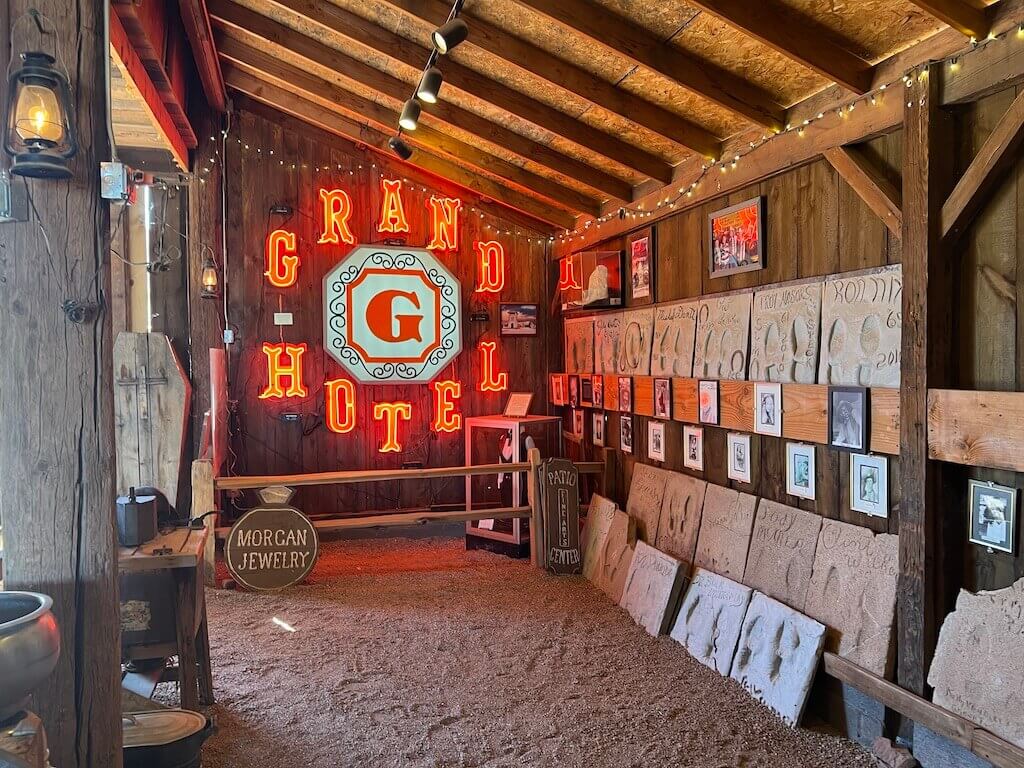
Nostalgia is also afoot inside of the Apacheland Barn as famous actors and actresses cast their footprints in concrete squares which are placed along the southern wall of the Apacheland Barn – this portion of the Barn is called, “The Footprints of the Stars”.
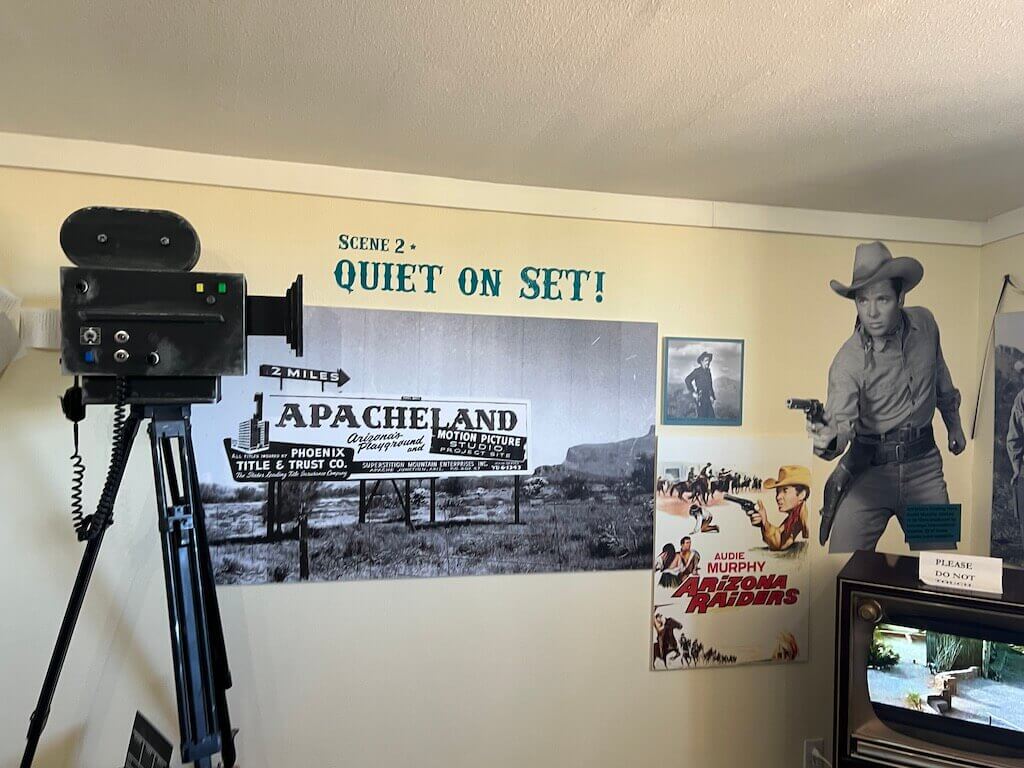 Another portion inside of the Apacheland Barn to note is the room dedicated to classic Western movies. Take a walk around this room and see how a Western film was made. A wide variety of western movie posters, and photos of Hollywood stars that line the room’s walls. You can feel the significance of this exhibit and how it shaped Hollywood films as people from all over the world come to visit Arizona to feel the old west based on the movies and tv shows they saw, many of which were filmed right here in the East Valley.
Another portion inside of the Apacheland Barn to note is the room dedicated to classic Western movies. Take a walk around this room and see how a Western film was made. A wide variety of western movie posters, and photos of Hollywood stars that line the room’s walls. You can feel the significance of this exhibit and how it shaped Hollywood films as people from all over the world come to visit Arizona to feel the old west based on the movies and tv shows they saw, many of which were filmed right here in the East Valley.
While I could spend all day learning about old Western films, I wanted to experience the outside a little more, so I decided to go on the Nature Trail which interconnects with several other outside museum exhibits.
Superstition Mountain Museum Nature Trail
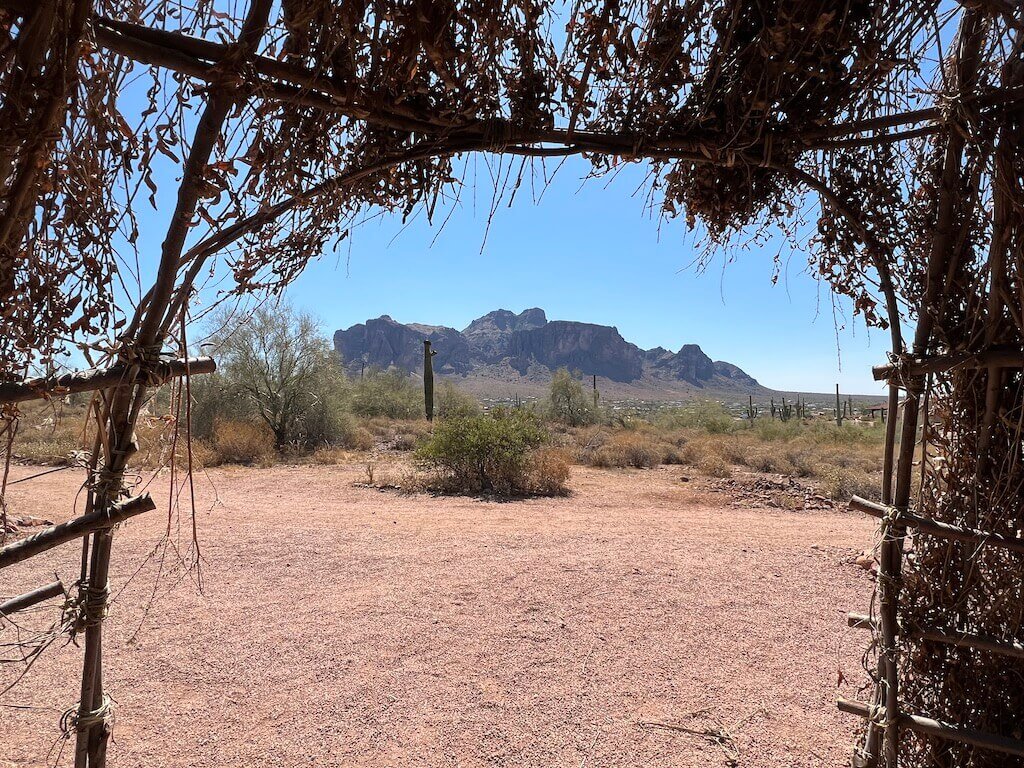 What better way is there to experience the Superstition Mountains at the museum than to actually see the magnificent mountains in the background as one learns about its past? As I traversed the 1/3 mile track, I learned about the local desert plants that span the area such as Chain Fruit Chollas, Creosote Bushes, and the iconic Saguaro Cacti. I also immersed myself in the interactive experiences such as sitting inside a Wickiup which is a temporary housing structure that the Apache people would construct and live in during the winter months. I also witnessed all of the mining equipment that adorned part of the Nature Trail as mining was one of the main drivers for settlers to call this area home.
What better way is there to experience the Superstition Mountains at the museum than to actually see the magnificent mountains in the background as one learns about its past? As I traversed the 1/3 mile track, I learned about the local desert plants that span the area such as Chain Fruit Chollas, Creosote Bushes, and the iconic Saguaro Cacti. I also immersed myself in the interactive experiences such as sitting inside a Wickiup which is a temporary housing structure that the Apache people would construct and live in during the winter months. I also witnessed all of the mining equipment that adorned part of the Nature Trail as mining was one of the main drivers for settlers to call this area home.
Mining 101
The amount of equipment needed to mine precious materials such as gold and silver is mind-boggling, but there was a surprisingly simple piece of equipment called an arrastre that would allow for the milling and extraction of gold onsite. This circular piece of equipment is similar to the functionality of a grinding stone and was powered by horses to help break up ore chunks into powder. Gold is easier to extract when the ore is broken down into a powder and it appears that arrastre has been used for hundreds of years. Who knew I could learn so much about mining for gold with the Superstition Mountains as a backdrop?
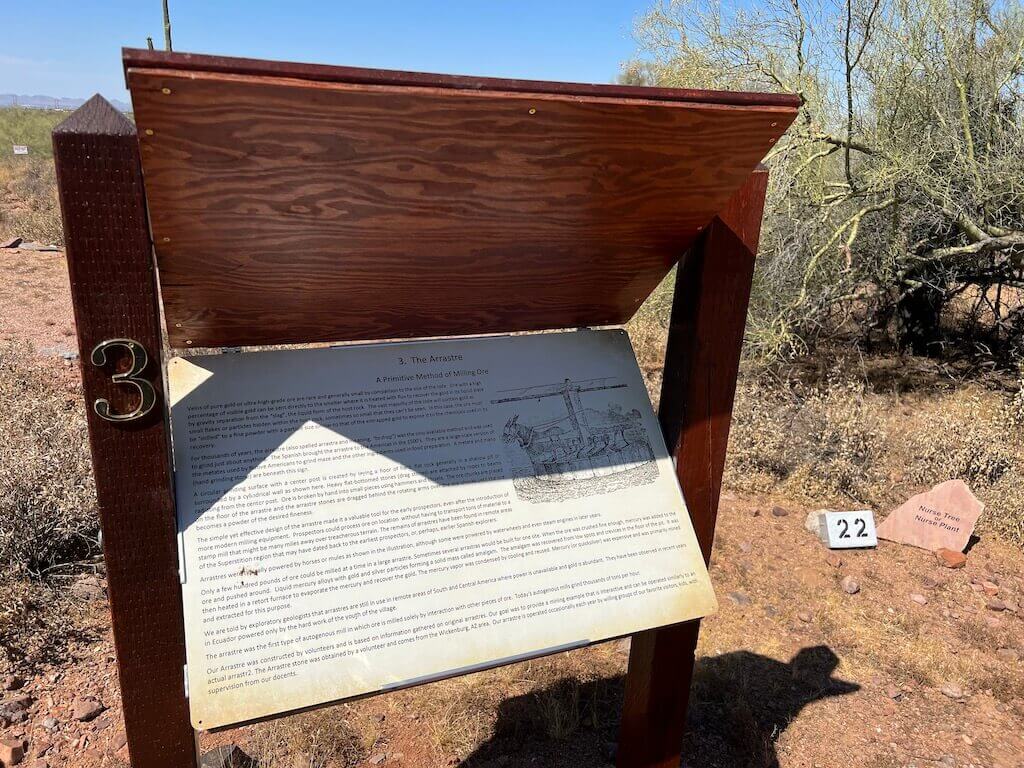 The volunteers and staffers at the museum do offer speaking sessions on how the equipment was used and how mining grew in this area during the winter months, so I am likely to create a follow-up blog on the museum during the planned winter month activities. With the Nature Walk accomplished and my mind is filled with knowledge on how to mine, I wanted to save one of the coolest portions of the property for last, the Elvis Memorial Chapel.
The volunteers and staffers at the museum do offer speaking sessions on how the equipment was used and how mining grew in this area during the winter months, so I am likely to create a follow-up blog on the museum during the planned winter month activities. With the Nature Walk accomplished and my mind is filled with knowledge on how to mine, I wanted to save one of the coolest portions of the property for last, the Elvis Memorial Chapel.
Elvis Memorial Chapel
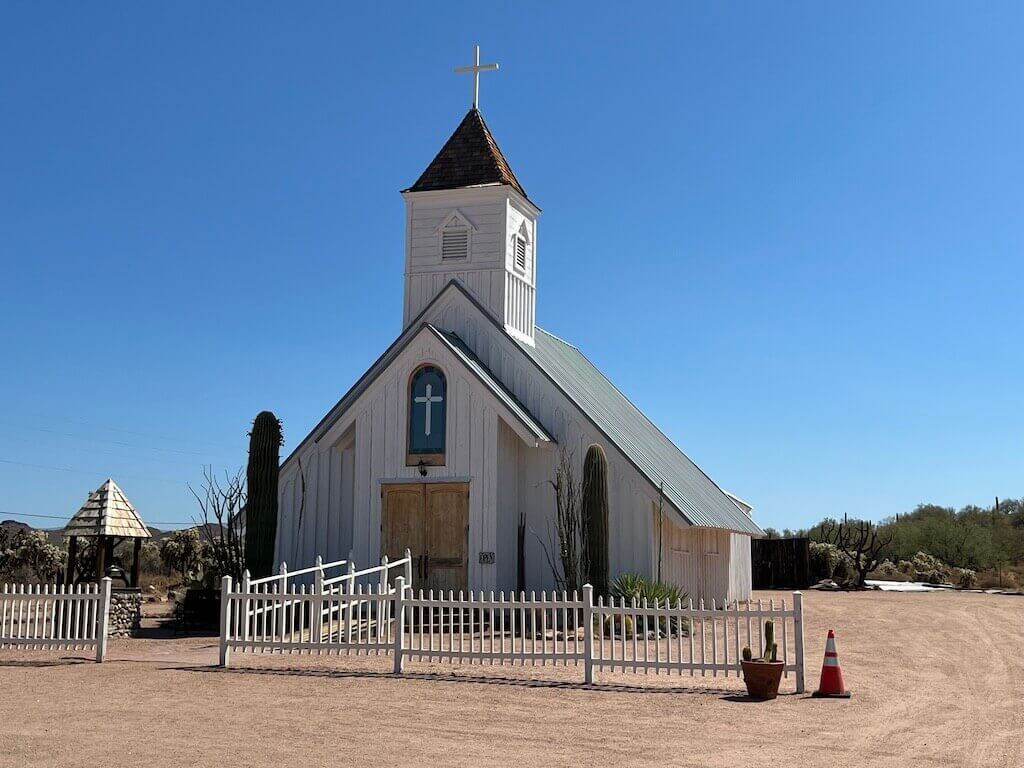 Who says you have to travel to Las Vegas to walk in the footsteps of Elvis? Not this blogger! Just travel to the Apache Junction area and check out the famous chapel that starred alongside Elvin Presley in the Western feature film Charro! As soon as you walk into this white, wood-clad structure, you are immediately graced with a statue of Elvis Presley himself with one of his iconic dance moves.
Who says you have to travel to Las Vegas to walk in the footsteps of Elvis? Not this blogger! Just travel to the Apache Junction area and check out the famous chapel that starred alongside Elvin Presley in the Western feature film Charro! As soon as you walk into this white, wood-clad structure, you are immediately graced with a statue of Elvis Presley himself with one of his iconic dance moves.
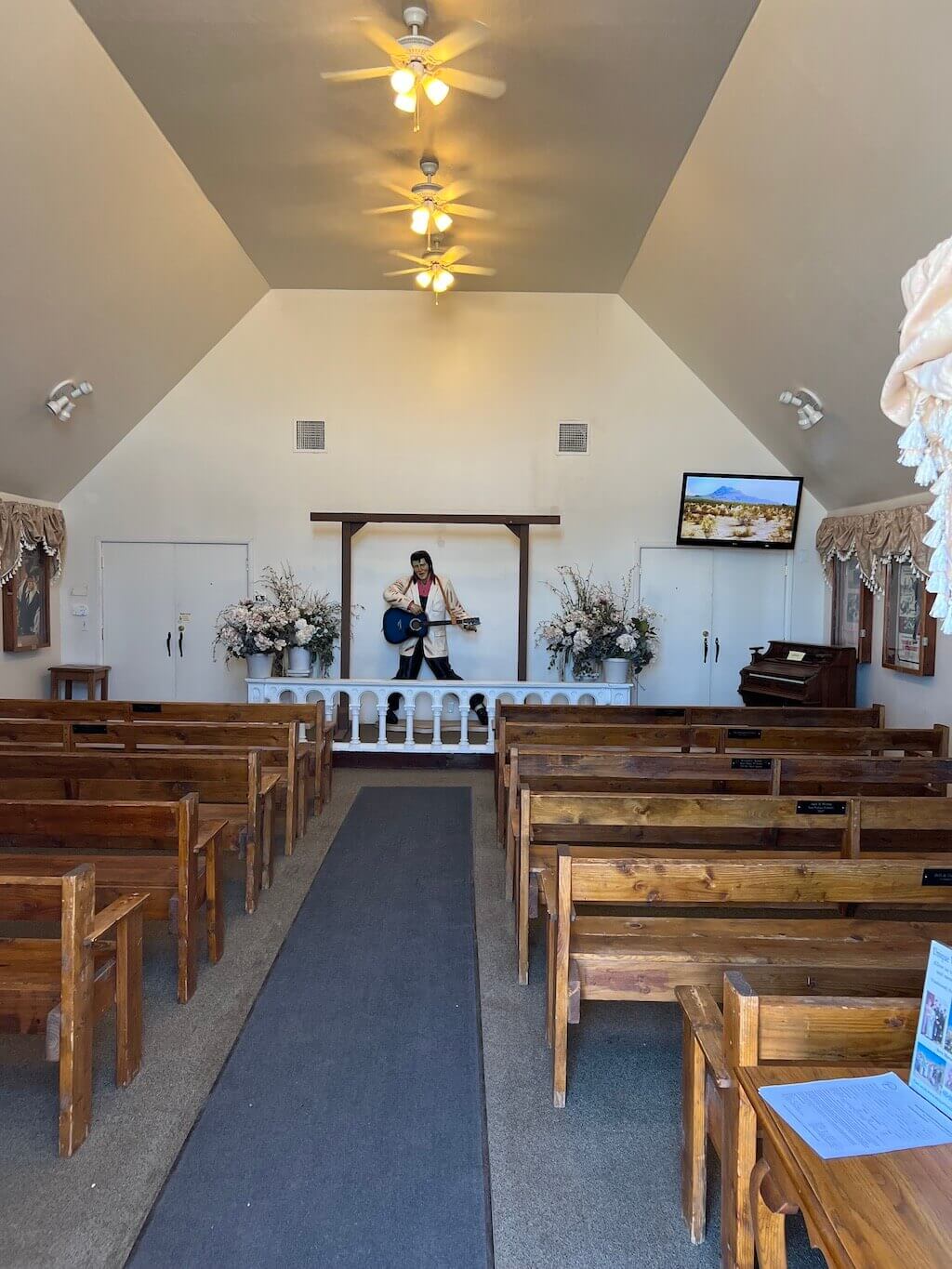 The walls of the chapel are filled with posters, photos, and artwork featuring Apacheland Move Ranch and the buildings that made up this memorable movie set. Here’s a fun fact, the Elvis Chapel can be rented out for actual weddings! Check out the details, by clicking here.
The walls of the chapel are filled with posters, photos, and artwork featuring Apacheland Move Ranch and the buildings that made up this memorable movie set. Here’s a fun fact, the Elvis Chapel can be rented out for actual weddings! Check out the details, by clicking here.
Final Thoughts
Whew! That was a lot to blog about and I did not even touch on everything there is to do at Superstition Mountain Museum. I will note, one of the most shocking tidbits I learned from attending the Superstition Mountain Museum is that this 15-acre campus is solely run by a fully volunteer-based organization. Even more surprising is that nearly everything that you can experience is free. There are several donation bins located throughout the property and part of the indoor museum exhibits costs a small fee to enter, but it is worth it to experience the tools, historical clothing, photos, art, and other artifacts that adorn the walls and the display cases. This museumgoer will certainly be back as more events, exhibits, and activities are offered in the winter months such as a live shootout and the reactivation of the iconic model train set. Going to the Superstition Mountain Museum is a great place to go year-round as there are several indoor and outdoor events and venues to encounter in various months.
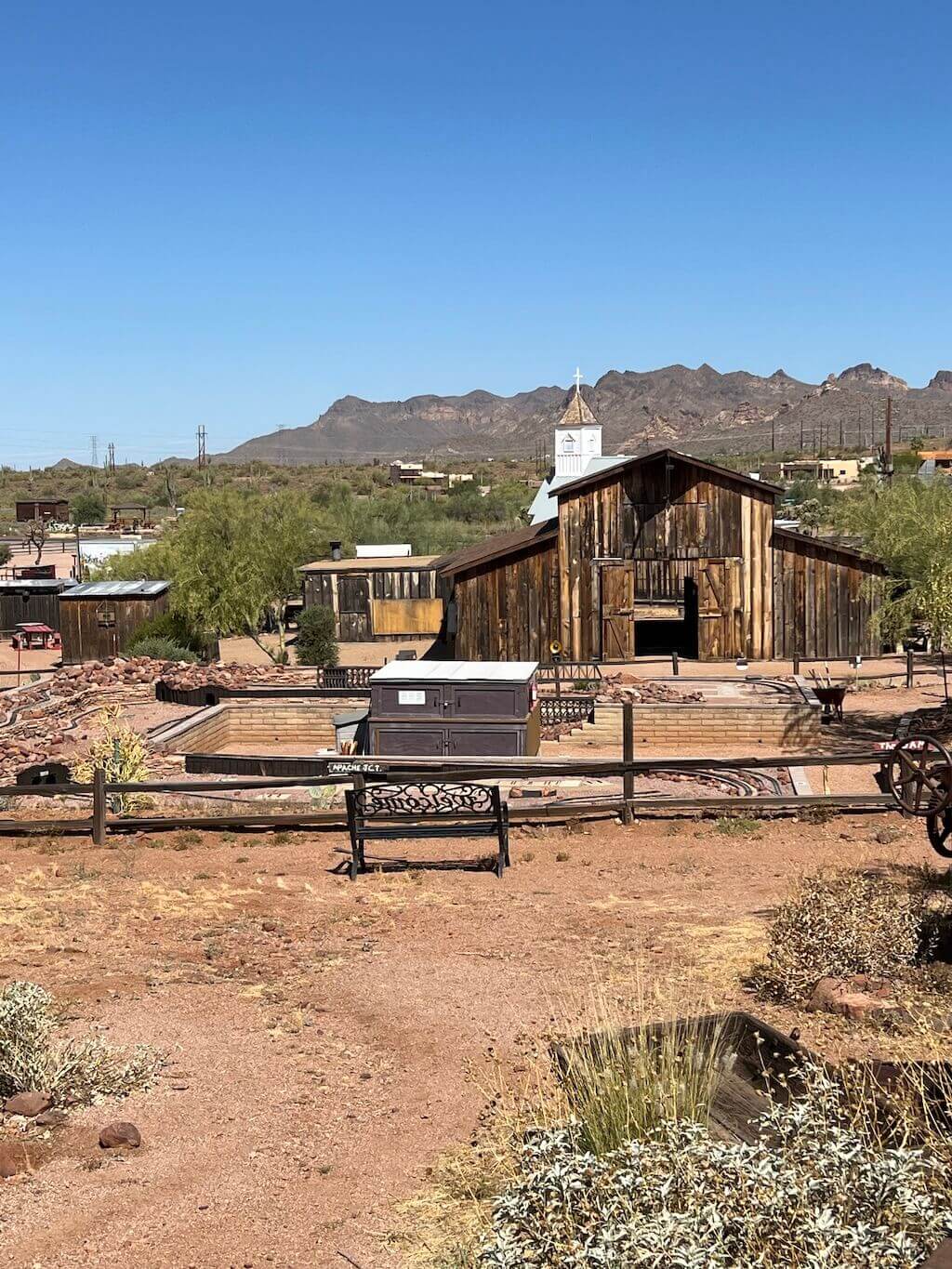
Note, all facts and figures identified in this post were cited from the displays found at the Superstition Mount Museum. Thank you to the wonderful representatives and volunteers that helped make this experience so memorable.
